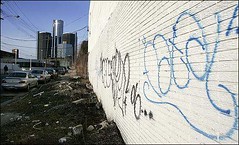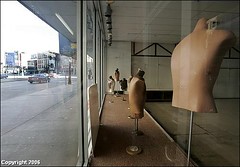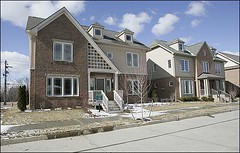Straight talk on sports as economic development...
Today's Richmond T-D's commercial real estate column focuses upon the latest iteration of plans to build a new minor league baseball stadium in the city, the Shockoe Bottom proposal having been scuttled. The piece, "Wilder's new ballpark plan still strikes out," pulls no punches. The author, Brian Glass, is senior vice president for Grubb & Ellis/Harrison & Bates. Clearly, he drinks different kool aid compared to his colleagues in the Washington region. And, he reads books too!
From the column:
I have just finished reading Public Dollars, Private Stadiums: The Battle over Building Sports Stadiums by Kevin Delaney and Rick Eckstein. Their study covered the battles involving cities where new major-league stadiums were constructed and where they weren't. The arguments for building new stadiums as they stated were:
• They would generate economic development.
• They were essential for "community self-esteem."
There is no evidence that a new stadium is an economic generator. Coors Field in Denver was a classic example. The LoDo area of Denver was a close equivalent to our Shockoe Bottom and was developing, residentially and commercially, long before the stadium arrived. Future development actually moved away from the ballpark, with the exception of some restaurants that were there before the stadium.
When voters turned down efforts to build stadiums based on the economic-development model, most of the cities switched to the "community self-esteem" argument: "If we don't build it, they will leave, and we will become a second-class city."
With the exceptions of San Francisco and Minneapolis (San Francisco's stadium was built primarily with private dollars from the team owners, and Minneapolis didn't get a new stadium), this model actually worked. Every stadium that was built was over budget, and the team owners reaped the monetary rewards while the taxpayers footed the bills.
Time Warner owns both the Atlanta Braves and the Richmond Braves. It is no secret that Time Warner is trying to sell the teams. My question is this: What incentive is there for Time Warner to spend its money for a new stadium when it plans to sell its baseball teams? On the other hand, if there is a commitment to build a stadium without their dollars, doesn't it stand to reason that the value of the team increases to the benefit of (guess who) Time Warner?
Although there have been no details regarding the financing of a new stadium, you can bet that it will be the taxpayers who are on the hook...
 David Coates / The Detroit News. Graffiti has reappeared at several Detroit buildings, including at this site on Woodbridge. At the Griswold Parking Garage, a long line of graffiti was scrawled on walls that had been scrubbed for the Super Bowl.
David Coates / The Detroit News. Graffiti has reappeared at several Detroit buildings, including at this site on Woodbridge. At the Griswold Parking Garage, a long line of graffiti was scrawled on walls that had been scrubbed for the Super Bowl.And Sunday's Detroit News had two very interesting articles, one about Detroit after the Super Bowl, and the other about a long term neighborhood improvement project. The first article, "One month later, Super efforts fade: Detroit needs more than football game to clean up image," states:
One month after the game, city residents and businesses fret that the positive impact they expected from the sports spectacle is no more visible than those spindly seedlings in the dark. Litter and graffiti have begun to reappear downtown and along highways. Storefronts on Woodward Avenue and other main drags are empty once again, with few prospects for new tenants.
Sales at downtown businesses, which spiked during Super Bowl week, have returned to pregame levels, indicating that the football game has failed to entice suburban residents to revisit the city. "We've got a long way to go, I can't kid you," said Greg Gedda, owner of the Union Street restaurant, a 20-year fixture on Woodward. "There's more to do down here."
A national survey found that Detroit's image wasn't changed by the largely positive media coverage of the Super Bowl. Competitive Edge Research & Communication, which questioned 500 people before and after the game, found that they continued to hold negative views about Detroit by a 2-to-1 margin. "The Super Bowl doesn't turn a trailer park city into a gleaming palace overnight," said pollster John Nienstedt, whose San Diego firm has conducted such surveys for the last four Super Bowls.
Just like urban design is about connection and context, long term sustainable economic development is about connection and context. A single event ends up being a lot like a copper mine in Chile, connected to the sea by a railroad serving only the mine, depositing ore in ships flying the flag and with crewmen from another country, with the copper to be processed for higher value elsewhere. The mine is "economic development," but without any connection to the community beyond its barb-wire topped fences, it provides no assistance towards the objective of building a local economy. Instead, it's enclave development, and it's not a whole lot different than expecting a one-shot event to yield long-term benefits.
It kills me that so many rehabilitatable and historic buildings and artifacts were demolished in advance of the Super Bowl, "to make the city look better," and now Detroit is once again the same city in the throes of a financial crisis, but with even more empty lots (note that Detroit has 55 square miles of empty land).
Another article in the same edition of the paper, "Core City quietly builds up its own little corner of town," could be thought of as the "tortoise" example of community economic development, compared to the "hare" of sports-based projects, in thinking about a new parable for the 21st century and urban revitalization.
Working in a single neighborhood, one with plenty of vacant lots and deteriorating buildings, in seven years the Core City Community Development Corporation has built 275 houses, and the neighborhood is beginning to turn around. Focus makes a huge difference. From the article:
Last year, the nonprofit group got help from Habitat for Humanity, which had a blitz of building 30 homes north of Martin Luther King in one week with the assistance of former President Jimmy Carter. "They can go so much faster than us," said Campbell, explaining the difference is Habitat for Humanity's core of volunteers. By comparison, it took Core City five months to build 26 units.
Core City focuses on the near west side of Detroit, just off Grand River. The group's next big project, Campbell said, is a commercial building where Martin Luther King, Trumbull and Grand River join. Most of the homes Core City sells -- with a price of about $100,000 -- are going to people who had lived in the city and now want to return. ...
They are self-deprecating over the fact that it took them five months to build 26 units of housing! For a community development corporation in just about any city, 26 units of housing in one year is an impressive number, let alone 5 months. This is an amount of housing production much greater than the average CDC in most cities outside of New York City.
In the long-term, which effort is likely to have more real impact on Detroit? The efforts of Core City or the Super Bowl? And the Core City effort is but one of over 100 similar efforts across the city. Hopefully the other organizations are as single-minded!
 David Coates / The Detroit News. During the Super Bowl, this storefront at 138 Monroe was filled with Big Game gear. A month later, it sits empty.
David Coates / The Detroit News. During the Super Bowl, this storefront at 138 Monroe was filled with Big Game gear. A month later, it sits empty. Clarence Tabb Jr. / The Detroit News. In the past seven years, the nonprofit organization Core City has built more than 275 units in the neighborhood west of Grand River, including these off Selden near the Lodge Freeway. The group's next big project is a commercial building.
Clarence Tabb Jr. / The Detroit News. In the past seven years, the nonprofit organization Core City has built more than 275 units in the neighborhood west of Grand River, including these off Selden near the Lodge Freeway. The group's next big project is a commercial building.Index Keywords: stadiums-arenas



0 Comments:
Post a Comment
<< Home